"Tally Ho!" Eduard 1/48 limited release Spitfire IIa and IIb
History:
The Type 300 prototype, serial K5054, first flew on March 5, 1936. In May 1936, the Air Ministry agreed to the name “Spitfire” for the Type 300. On June 3, 1936, the Air Ministry ordered production of 310 Spitfire Mk Is. Putting the Spitfire into mass production was far more difficult than originally anticipated. Supermarine had experience producing small batches of virtually hand-built aircraft, and almost all of Mitchell's produced designs had been one-offs. The beautiful elliptical wing was one of the greatest sources of difficulty, since each rib was an individual size. The reorganization of production consumed more time than expected, to the dismay of the Air Ministry, who were pressing for early deliveries of the new fighter; Supermarine was reluctant to provide information to sub-contractors, but this was eventually resolved by the Air Ministry. Adding to the difficulties, R. J. Mitchell died of cancer on June 11, 1937. Responsibility for the further development of the Spitfire became the responsibility of Mitchell's assistant, Joseph Smith, who skillfully managed the successful evolution of the aircraft through 40 different variants, while retaining its essential fighting qualities.
Because of these production delays, the RAF had received only 49 Spitfires by January 1, 1939. As the Munich Crisis loomed in the summer of 1938, the production crisis resulted in the construction of a huge new ‘Shadow Factory' at Castle Bromwich, intend only for Spitfire production, to be operated by the Nuffield Group ((William Morris). By May 1940, delays at the factory led to newly-installed Minister of Aircraft Production Lord Beaverbrook having a conversation with Lord Nuffield over the delays, in which Nuffield told Beaverbrook that if he didn't like the way things were, he should produce them himself; Beaverbook did just that, installing a management team from Supermarine by the end of the month. The factory commenced production with the Supermarine Type 329, known as the Spitfire II, which was essentially a late-production Mk. I with the Merlin XII engine that used 100-octane fuel, and was produced only at Castle Bromwich. The main outward difference between the Mk. I and the Mk.II was the Mk.II being equipped with a Rotol constant-speed propeller with a more bulbous spinner, and a fairing on the starboard cowling over a Coffman cartridge starter (Many Spitfire II's did use the deHavilland prop due to production delays of the Rotol prop); the Spitfire II also adopted all the changes of the late-production Mark I, including a motor-driven hydraulic gear retraction, full armor protection and the new laminate seat. The first ten rolled off the line in June 1940, being modified Mark I airframes. By the time production ended in March 1941, 921 Spitfire IIa's were produced, along with 178 cannon-armed Iib's.
The Eagle Squadrons:
In the mythology of aerial warfare, the Eagle Squadrons - “the Yanks in the RAF” - rank with the Lafayette Escadrille and the American Volunteer Group for mystique. The Eagles were far more like the young pilots of the Escadrille Lafayette - none were professionals before joining the unit - than the AVG, all of whom were professional Army, Navy or Marine Corps pilots, whose mission was underwritten by the U.S. government. For the young men who joined the Eagle Squadrons, the act of crossing the border to Canada meant breaking the Neutrality Act; several were arrested by the FBI more than once before successfully getting there.
With the outbreak of war in 1939, Charles Sweeney, a wealthy American businessman in London, organized recruitment of Americans to join the French in the tradition of the Lafayette Escadrille. With the fall of France, a dozen of these recruits joined the RAF, including my father's old schoolmate Andy Mamedoff, “Red” Tobin and “Shorty” Keough, who had been trying to join the war by volunteering to fly for the Finns in the Winter War before going to France, which they had to escape from.(My father only missed joining his friend due to the death of his father, and the sudden need of his assuming responsibility of caring for his mother. Since all the early Eagles died in the war, I consider this fortuitous.)
By the summer of 1940, the British government wanted as many Americans in RAF uniform as possible as props in the propaganda effort to swing American opinion in favor the the Allies. Sweeney's operation was coordinated in Canada with the support of World War I air ace Billy Bishop and in the United States with well-known aviation artist Clayton Knight, who founded the Clayton Knight Committee. By Pearl Harbor, the Knight Committee had processed and approved 6,700 applications from Americans to enter either the RCAF or RAF. The cost of all this was about $100,000 in 1940s dollars (over a few million today) and it was completely covered by Sweeney and his rich society contacts.
Most of those among the early volunteers were adventurers with some flight experience, none of it up to military standards. My old friend, the late film producer and agent Barry Mahon (who was the real "Cooler King" at Stalag Luft III), told me he had approximately 70 hours in light planes when he went to Canada during the Battle of Britain. He “padded” his flight log with 430 non-existent hours including 100 in the “advanced” (controllable prop and retractable gear) Spartan Executive. When he got to his Canadian training base, he was told to go fly a BT-16 Yale - which was far beyond his capabilities - and actually managed to take off, make a circuit and put it back on the ground in one piece. Fortunately, the instructors recognized his need for additional training. Later, in 1941, many of those who went to Canada and joined the RCAF were cadets who had washed out of USAAC training schools; the fact that several of them later became aces is indicative of either too-high American standards, or better Canadian training.
In November 1941, 71 “Eagle” Squadron was formed at Martlesham Heath, originally equipped with Brewster Buffalos, which the young Americans thought was terrific - American pilots going into battle in American planes - until they flew the Buffalo and realized how bad it was. They were glad to get Hurricane Is that December.
71 Eagle Squadron entered combat in May 1941. By August, they had demonstrated such potential they were given passed-down Spitfire IIs in place of the Hurricanes and assigned to the Biggin Hill Wing.
Bill Dunn: America's First Ace of World War II:
Born in Minneapolis on November 16, 1916, Bill Dunn ran away from home in 1934, at age 17, and joined the Army, being discharged in 1936. With the outbreak of war, he joined the Canadian Army as a member of the Seaforth Highlanders. Arriving in Britain in April 1940, he trained as an AA gunner and claimed - with other gunners - two Ju-87's shot down while attacking Borden army camp on August 16, 1940.
In September, Dunn transferred to the RAF, and completed training in April 1941, then sent to 71 “Eagle” Squadron. The working class Dunn did not fit in with the somewhat cliquish members of the unit, many of whom were products of private school educations; most importantly, he got off on the wrong foot with Flight Lieutenant Chesley Petersen, the highest-ranking American in the unit who had just become a Flight Leader and was the center of the dominant “clique.” Dunn's relationship with the Eagles was further exacerbated by the fact he was an uncommonly-good pilot, becoming first in the squadron to shoot down an enemy aircraft, on July 2, 1941. By early August, Dunn's score stood at 3, scored in Hurricanes, and he was tied with Gus Daymond as lead.
71 Squadron was issued with Spitfires on August 17, 1941, and assigned to the Biggin Hill Wing. On August 27, 1941, in a swirling dogfight over northern France, Dunn shot down two Bf-109Fs, to become the first American ace of the war. However, he was badly wounded in the right leg during the fight, and crash-landed at Manston, from where he was immediately sent to the hospital for what became a lengthy recovery that lasted into 1942. In the meantime, the more popular Daymond managed to score two victories in early September, and was proclaimed the first American Ace by his comrades. This mistake in the history books would not be corrected officially until 1969, when the American Fighter Aces Association verified Dunn's claims. His autobiography, Fighter Pilot: The First American Ace of World War II, is well worth tracking down and reading.
The Spitfire IIb:
The Spitfire IIb was developed from the Spitfire Ib, which was unsuccessful when introduced in July 1941 in 19 Squadron, due to the cannon feed jamming under the stress of combat maneuvering. The IIb received modification to the feed mechanism, and was put on the production line in early August 1940. It arrived in the squadrons after the Battle of Britain, equipping only a few. Among these were 303 “Kosciuszko” and 306 “Torun” Polish squadrons, which had proven themselves when finally turned loose in the Battle of Britain at the end of August 1940.306 “Torun” Squadron received Spitfire IIb's as “hand me downs” in July 1941 and used them until September, when they re-equipped with the Spitfire V. Many Spitfire IIb's were modified with the Merlin 45 engine of the Spitfire V and re-released as such in 1942.
The Kit:
The Spitfire IIa and IIb are the second early Spitfire kits from Eduard, following the early and late Spitfire I. Like the earlier kit, the first release was a double kit combo; the Spitfire Iia has already been released by itself as a Profipack kit this month, and Overtrees are also available according to one of my “cheepascotty” friends who bought two. The IIb will be available in April or thereabouts.
The main difference between the two is the wing, with the second kit having the “B” wing with a single 20mm cannon in a drum, resulting in streamlined bulged fairings above and below the wing. Other than that, if you have seen the first kits, you have seen this one.
Decals are provided for no less than ten airplanes, eight IIa's and two IIb's (one from 303 Squadron, one from 306). Since the Spitfire II's service was during a period of markings changes as the RAF moved from defensive to offensive operations, there are a plethora of different markings of aircraft in Dark Earth/Dark Green/Sky, with and without the black lower left wing, and those in the new Ocean Grey/Dark Green/Sea Grey Medium scheme. Sadly, Eduard does not mention that the majority of these were not in that scheme, but were rather in “mixed greys” both upper and lower, due to paint unavailability in the summer of 1941 when the change was ordered. The result was a multitude of shades and hues as squadrons “made do.” The upper color was mostly done by mixing black and white, getting various shades of “darkish” grey, while the lower surfaces were frequently left in Sky, or painted in greys like British Light Grey, Light Sea Grey, Sky Grey or a lighter-shade mixture of black and white. A modeler can have a lot of fun with this, and since 99% of the “photographic proof” is black and white photos, no one can say with certainty what is right or wrong.
It is nice to note that Eduard has taken heed to the complaints that their new in-house decals were too thin and not opaque enough. The yellow is now much more acceptable, while the other colors are opaque enough to cover different dark colors beneath.
One other thing to note is that the parts for a Spitfire V are in the kit now, on their own separate tree. The deeper oil cooler is used for the cannon-armed version. There are also parts that will allow the slightly-deeper radiator housing, metal ailerons, the different horizontal stabiliizers and elevators,(I bet you, like me, didn't know there was such a difference - in rivet pattern and fabric pattern - something nobody but Eduard would pay attention to)and the three different Spitfire V props and spinners. Thus, a modeler can use the metal ailerons from this sprue to do Bader's Spitfire II or any other Tangmere Wing Spitfire II that was modified with these ailerons. One can use those ailerons and the deeper oil cooler and radiator and do a Spitfire Va, or with the cannon-armed airplane one could do all versions of the Vb other than tropical, since the later canopies and windscreens are also there on the clear sprue. In other words, there is a lot of value in this kit.
Construction:
As with all the other new Eduard kits of the past several years, the design of these kits is very precise, and ham-handedness will guarantee a less-than-desired result. All sprue nibs need to be trimmed off and the mating surface smoothed, and no paint on those surfaces. Take your time, follow the instructions, and you will get a nice result. Of note, all Spitfire IIs used the paper laminate seat, which is painted brown.
Colors and Markings:
Over the years considerable confusion about the camouflage and markings of Dunn's Spitfire IIa P7308, in which he scored the two victories that made him an ace. Dunn himself helped with these mistakes with his painting of his airplane - which many at the time assumed must be right since it was done by the man who had flown it - which has the wrong camouflage colors and squadron code placement. Aeromaster compounded the mistake when they released their 1/48 sheet of American Eagle Squadron airplanes, in which they accepted Dunn's depiction of the airplane. Fortunately, Xtradecal got it right with their sheet for 1/32 Spitfire II's.
The Eagles received their Spitfires on August 17, two days after August 15, 1941, which is an important date in the history of RAF camouflage. On that date, all RAF fighters were to be repainted in the new “Temperate Day Scheme” of a disruptive upper pattern of Dark Green and the new Ocean Grey, with the lower surfaces painted Sea Grey Medium. There was a shortage of the new Ocean Grey, and so the directive stated that the upper color could also be a “Mixed Grey” obtained with a 50-50 mixture of Sea Grey Medium and Night (Black), or with black and white. Since all of this was done “in the field,” the results differed markedly from unit to unit, with the upper color ranging from a very light to a very dark grey. In the old Profile publication, “Camouflage and Markings: Spitfire in Northern Europe,” one of the profiles is of P7308, and it is the only source that clearly states that the colors were Mixed Grey and Dark Green upper surfaces, though they get Sea Grey Medium lower surfaces, which is likely incorrect. However, given that the entire photo proof for this airplane is two B&W photos, such mistakes are understandable, and you can safely follow Eduard's suggestions - if you substitute "Mixed Grey"..
I first learned of the Sky undersurface when I asked Barry Mahon about this 38 years ago. He told me all their Spitfires came from other units, and some were in grey, some were in sky, and “some were even blue.” This also applied to the codes; since the RAF had specified “Sky Blue,” by which they actually meant what is now known as “Duck Egg Blue” (which Eduard gets right on their sheet), some squadrons took that literally and did the “Duck Egg Blue” areas in a light blue.
What is most likely is that on August 27, 1941, P7308 was painted in the “B” scheme camouflage, with upper colors Mixed Grey and Dark Green, with lower surfaces Sky, the spinner, fuselage band and codes in light blue. (If you don't want to go to the effort to correct for this, no one can prove you wrong if you use the Eduard decals unmodified, and it in greys) Since these colors would have been applied at the base level, they would also have been “freehanded” with a spray gun, resulting in soft edges for all three colors, with Mixed Grey overspray on the Dark Green, which would have been the only color not repainted. (A British reader of this review at Modeling Madness e-mailed me with the story of his great grandfather, a young RAF Fitter during the war, who participated in the "overnight paint work" in August 1941; according to him, most of the repainting was done with brushes, which makes sense - you can take that into consideration in doing your model)
For Dunn's airplane, I used Tamiya XF-53 “Neutral Grey” for the upper color, with Tamiya XF-82 “RAF Dark Green” and Tamiya “Sky” with 30 percent white mixed in to get the correct shade. The “sky Blue” was a mixture of Tamiya XF-4 Flat Blue and XF-2 Flat White.
For the Spitfire IIb, I used Tamiya XF-54 “Dark Sea Grey” for the upper grey, XF-82 RAF Dark Green, and the lower surface in XF-19 “Sky Grey”. You can also vary this - no one can prove you wrong.
I used the kit decals, with the Dunn markings modified by outlining the letters with a #11 blade, then painting them the same light blue as the kit. When it came to applying them, I slid the decal film away then applied them (since there was a high likelihood of screwing this up, I did the codes and fuselage insignia first, in case I was going to be repainting the model for a different option). Dunn's book has a photo that shows him standing in front of a Spitfire nose where that Eagle Squadron marking is not visible; according to Barry Mahon, not all the first Spitfires had that, so whether that is P7308 is unknown, but likely it is. I decided I wanted it.
Since both airplanes were only with their respective squadrons for less than two weeks after a complete repaint, I did not “ding” the models, but did apply Tamiya “Smoke” for the exhaust stains and the oil stains on the belly and rear fuselage.
Conclusions:
They're Eduard Spitfires, they're great! With attention and care, you get a great result. The markings options give you a lot of opportunity to do something different. Highly recommended
Review Kits courtesy of the Atlantic Magazine for declaring me a winner of one of their $100 gift cards for filling out a marketing questionnaire - the card lasted a whole 10 minutes after arrival in the mail before being converted into kits.
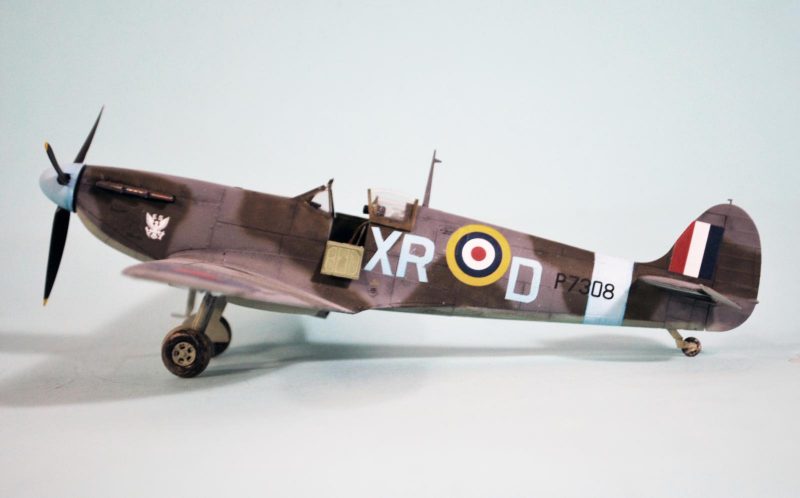
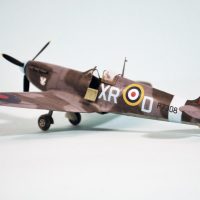
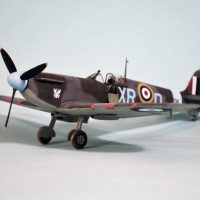
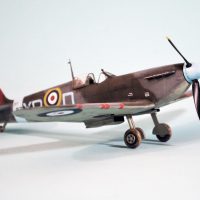
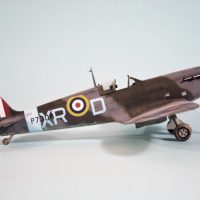
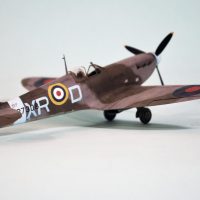

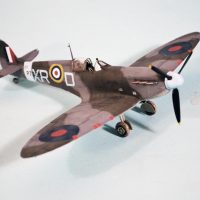
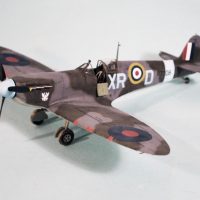
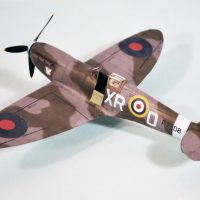
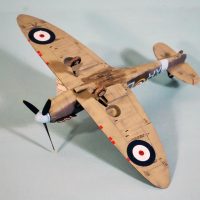
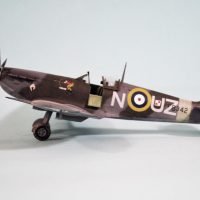
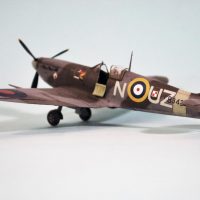
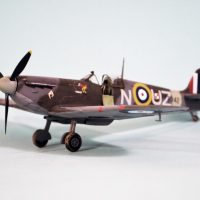
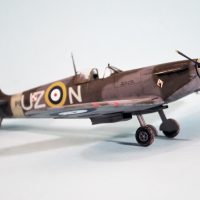

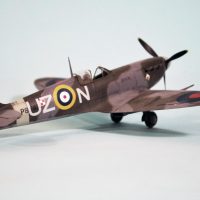

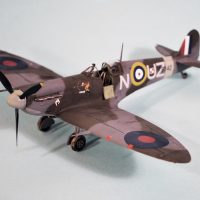
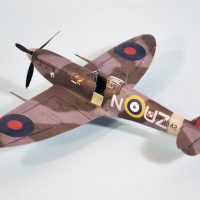
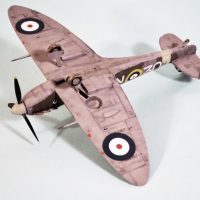
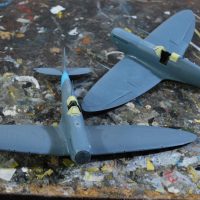
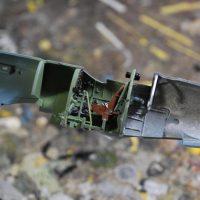
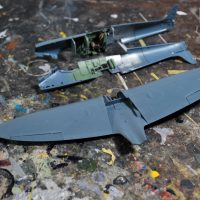
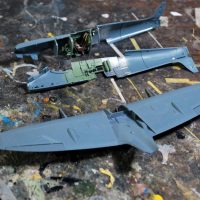
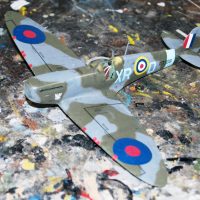
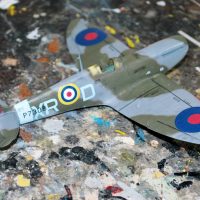
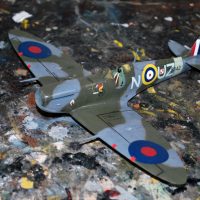
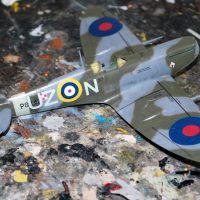
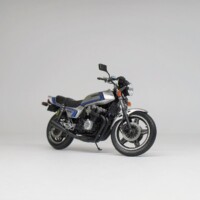
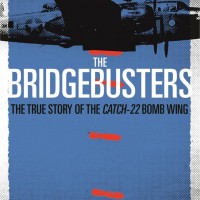
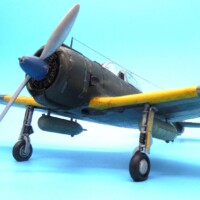
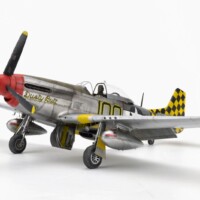
Looks great. Love the color scheme. With this inspiration, I hop to get started on my Eduard limited edition soon as well.
Nice work on both of these Tom. You weathering on the undersides is very well done.
Wow! Are you sure you didn’t relocate Castle Bromwich to SoCal, Tom? Nice work. Mk. IIs don’t get much attention.
@j-healy: Well, I do know the North American Aviation factory was relocated to Encino! 🙂
Thank you for the always thorough and comprehensive history of the subject and the building process from start to finish. I always learn something when I read your posts. And of course, the excellent finished product.
Ha! I should've read your reply before I wrote mine, now I sound like an echo. Well in this case I am an echo, totally agree.
I'm new here but a longtime lurker. I always love reading your writings, often the highlight of my hobby-related (anti-) social media day. I always learn something new from you. I especially like reading your P-51 articles.
I finally have the chance to personally thank you for recognizing the Hawk P-51's accuracy (in overall shape) amongst the early 1/48 Mustang kits.
Now I guess that makes Hasegawa, Tamiya, and AM the Middle Ages of P-51 kits.
Greg Fabian's Shangri-La post made me finally sign up the other night.
As always, beautiful and thoughtful work on these Spitfires. I love when thoughtfulness shines through in a finished model and yours always have that.
Thank you very much. I'm glad to welcome you aboard.
Impressive Pair of Deuces Tom and an excellent write up.
Always a pleasure to see and to read.
A lovely pair of Spits.!
Beautiful Spits and great background on the color schemes. I read Bill Dunham’s book “Fighter Pilot” many years ago and it has many great stories, I’ll have to look it up again to reread it. I remember that he liked the P-51B with the Malcolm hood because he could lean out and see underneath the plane.
Another one of your excellent builds, Tom.
I particularly liked the historical supporting text and the color research.
Great pair of Spitfires, Tom.
Like always, the provided history and building process is great.
Hi Tom!
Excelent builds... top notch as always..
Can you make a Spitfire IB from the IIB kit?
Regards
Yes. Use the deHavilland prop and don't put the Coffman Starter fairing on the cowling.
This addiction of yours . . .
Don't let it stop.
Great Spits! And I can't think of a better requiem for a gift card than "converted into kits!"